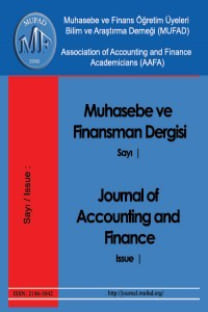Türkiye'de 1988-2008 dönemindeki firma birleşmeleri,birleşme dalgaları ve genel tablo
Bu çalışmada Türkiye´de 1988-2008 yılları arasında gerçekleşen firma birleşme ve satın almaları ileilgili işlemsel özelliklere bakılarak genel bir ampirik tablo sunulması amaçlanmıştır. Araştırmanın büyük birbölümü Thomson One veritabanı kullanılarak yapılmıştır. Bu tarihler içerisinde birleşme dalgası diyetanımlayabileceğimiz iki önemli dönem görülmüştür: Bunlardan biri 2000-2001, diğeri ise 2005-2008 yıllarıarasında gerçekleşmiştir. Fakat bu iki döneme baktığımızda işlem değerleri ve alıcı firma profilleri arasındafarklılıklar gözlemlenmiştir. 2005-2008 yılları arasında gerçekleşen satın almaları hem sayı hem de işlem değeriolarak yabancı alıcı firmalar domine etmiş, 2000-2001 yılları arasında ise sayı olarak yerli, değer açısından iseyine yabancı alıcı firmalar öne çıkmıştır. En aktif sektörler içerisinde işlem sayısı olarak bankacılık, hammaddeve imalat sanayii, işlem değeri olarak da ayrıca telekomünikasyon ve enerji sektörleri bulunmuştur. Son yıllardaalıcı firmanın hedef firmada kontrolü ele geçirdiği işlem sayısında bir artış görülmüştür
Mergers, acquisitions and merger waves in Turkey during the years of1988-2008
In this empirical study, we try to shed some light on the general patterns of merger and acquisitionactivity that occurred in the Turkish market during the years 1988-2008 with respect to deal characteristicsusing Thomson One as our primary database. In the last 20 years, there has been two major periods which canbe identified as a merger wave : One occurred during the years 2000-2001 and other during 2005-2008. However, when we look at these two periods, we noticed difference with respect to the total deal values and theacquirer profiles. The 2005-2008 period has been dominated by the foreign acquirers both with respect to thedeal numbers and also deal values whereas the 2000-2001 period has been dominated by the domestic acquirerswith respect to numbers and again by the foreign acquirers with respect to deal values. The most activeindustries, based on the number of acquisitions, have been the banking, materials and the industrials. If we lookat deal values, we also have to add telecommunications and energy and power to that list. Also, we found thatthe acquiring firms are mostly public and private firms whereas the target firms are mostly private firms andsubsidiaries. Finally, we found that the number of acquisitions after which the acquiring company gains controlof the target firm has increased in the last several years.
___
- Anbar, A. Karabıyık, L. (2010), Küresel Ekonomik Krizin Doğrudan Yabancı Yatırımlar Üzerindeki Etkisi, Muhasebe ve Finansman Dergisi, Sayı 46, Nisan, ss. 44-57.
- Andrade, G. Mitchell, M. Stafford, E. (2001), New Evidence and Perspectives on Mergers, Journal of Economic Perspectives, Vol. 15, pp. 103-120.
- Andrade, G. Stafford, E. (2004), Investigating the Economic Role of Mergers, Journal of Corporate Finance, Vol. 10, pp. 1-36.
- Chang, S. (1998), Takeovers of Privately Held Targets, Method of Payment and Bidder Returns , Journal of Finance, Vol. 53, pp. 773-784.
- Conn, R. Cosh, A. Guest, P. Hughes, A. (2005), The Impact on UK Acquirers of Domestic, Cross-border, Public and Private Acquisitions, Journal of Business Finance & Accounting, Vol. 32, pp. 815-870.
- Danbolt, J. (2004), Target company cross-border effects in acquisitions into the UK, European Financial Management, Vol. 10, pp. 83-108.
- Doukas, J. Travlos, N. (1988), The Effect of Corporate Multinationalism on Shareholders' Wealth: Evidence from International Acquisitions, Journal of Finance, Vol. 43, No.5, pp. 1161-1175.
- Eckbo, E. Thorburn, K. (2000) Gains to Bidder Firms Revisited: Domestic and Foreign Acquisitions in Canada , Journal of Financial and Quantitative Analysis, Vol. 35, pp. 1-25.
- Ertaş, F. (1998), Küreselleşme Sürecinde Türkiyede Şirket Birleşmesi, İktisat, İşletme ve Finans Dergisi, Cilt 13, Sayı 142, ss. 47-57.
- Fuller, K. Netter J. Stegemoller, M. (2002), What Do Returns to Acquiring Firms Tell us?, Journal of Finance, Vol. 57, pp. 1763-1793.
- Georgen, M. - Renneboog, L. (2004), Shareholder Wealth Effects of European Domestic and Cross- Border Takeover Bids, European Financial Management, Vol. 10, pp. 9-45.
- Göker, Z. (2007), Doğrudan Yabancı Yatırımların Ekonomik Etkisi, İktisat, İşletme ve Finans, Cilt 22, Sayı 253, ss. 31-45.
- Harford, J. (2005), What Drives Merger Waves, Journal of Financial Economics, Vol. 77, pp. 529- 560.
- Mandacı, P. E. (2004), Şirketlerin Birleşme ve Satın Alma Duyurularının Hisse Senedi Fiyatları Üzerine etkileri, İktisat, İşletme ve Finans Dergisi, Cilt 19, Sayı 225, ss. 118-124.
- Markides, C. Ittner, D. (1994), Shareholder Benefits from Corporate International Diversification: Evidence from U.S. International Acquisitions, Journal of International Business Studies, Vol. 25, pp. 343-366.
- Mitchell, M. Mulherin, H. (1996) The Impact of Industry Shocks on Takeover and Restructuring Activity, Journal of Financial Economics, Vol. 41, pp. 193-229.
- Mulherin, J. Boone, A. (2000), Comparing Acquisitions and Divestitures, Journal of Corporate Finance, Vol. 6, pp. 117-139.
- Thomson One Banker veritabanı, ( http://banker.thomsonib.com/)
- ISSN: 2146-3042
- Yayın Aralığı: Yılda 4 Sayı
- Başlangıç: 2005
- Yayıncı: Muhasebe ve Finansman Öğretim Üyeleri Derneği (MUFAD)
Sayıdaki Diğer Makaleler
Attitudes of accounting professions and businesses about ethics: Turkey case
Kobi'lerde ufrs ve basel II düzenlemelerinin farkındalığının araştırılması: Doğu marmara örneği
Cash flow statement that was reported according to Turkish accounting standards and its analysis
Türkiye'de 1988-2008 dönemindeki firma birleşmeleri,birleşme dalgaları ve genel tablo
Kurumsal kaynak planlama sistemlerinin muhasebe süreçlerine etkisine yönelik İMKB'de bir araştırma
Bankalarda vadeye kadar elde tutulacak menkul kıymet işlemleri ve etkin faiz yöntemi
